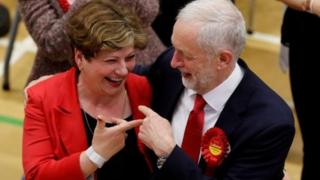 Image copyright
Image copyright
Reuters
In the afterglow of a better-than-expected general election result in 2017, Labour immediately set its sights on the path to government.
One of the party’s first steps was to announce the ambition to select candidates in 75 target seats in England by Christmas.
That’s more than the theoretical 64 seats they need to win for their own overall majority.
While that target was abandoned and ultimately not met, the BBC understands that Labour has now selected candidates in 25 of its target seats in England.
But who are they selecting?
- What Momentum’s wins might mean for Labour
- The local battles being fought within Labour
- What caused Labour’s youth vote surge?
In 17 of the seats in which Labour has run a selection process, the party has stipulated the choice must be made from an all-women shortlist.
No black candidates
This means eight seats have had the choice of holding an open selection, and in all eight of those Labour chose men to contest the seat in the event of a snap election.
Because of Labour’s 119 female MPs; if the party was to hold on to all its seats, and win in all 25 selected so far, 47% of Labour MPs would then be female – far higher than anything any party has put forward in the Commons before.
Labour has no party policies in place that would mean it has to run selections where the only candidates can be from black and minority ethnic backgrounds.
This means all seats have been open in this regard but, despite this, every candidate selected by Labour so far has been ethnically white.
Some 12% of Labour MPs are currently from a black and minority ethnic (BME) background – double the percentage of BME Conservative MPs.
Familiar faces
A problem for all parties before the 2017 snap election was trying to select a raft of candidates across the country in a very short period of time.
Having fewer MPs in the first place, and more incumbent MPs choosing to retire than any other party (13), meant Labour had more selections to make than the Conservatives.
Despite the original rush to select candidates before last year’s election, many of them have been brought back to stand again next time the UK is asked to go to the polls.
In 14 of the 25 seats selected so far, the local party has chosen the same candidate it had before, and in one other, the candidate has moved from a different constituency. Mhairi Threlfall, a Bristol city councillor, has moved from contesting Kingswood in 2017 to being named the candidate for Filton & Bradley Stoke.
All of the seats in which Labour has scheduled selection contests in the next few months are in England and in Conservative-held seats.
Labour Selections
Labour has set out to make selections in what it sees as “target seats” – but there are many seats on the list that would require a large swing from Conservatives to Labour in order for them to be won.
Many of them are seats that Labour has never held, even under the landslide Tony Blair victories of 1997 and 2001.
The party has already selected candidates in several seats where the swing required is greater than 5% – not normally considered “marginal”.
Seats in which Labour has selected candidates, such as Rugby, York Outer and South Ribble, are all places where a larger swing is needed to take the constituency.
However, Labour easily gained seats in 2017 far outside the 5% range, taking places like Brighton Kemptown and Battersea with more than double the swing required to be a marginal.
Labour’s candidates for general election target seats revealed}

